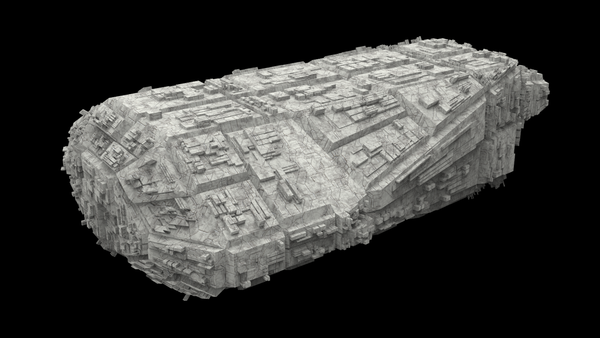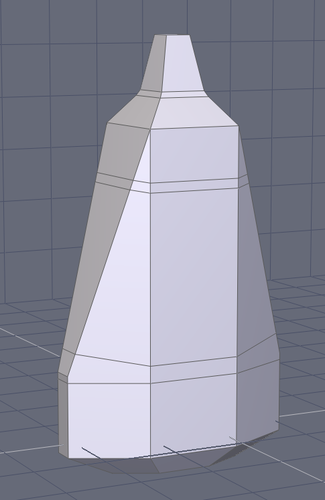Greebles!
 useroperator
Posts: 247
useroperator
Posts: 247
Too bad there is no easy way to do it in Hexagon :(
Wish Hexagon had plugins like this. This took literally less than a minute to make from start to finish. About 21K poly's in total. And the beauty is you almost can't go wrong with virtually any shape.
But it is somewhat easy to make a shape in comfy hexagon, then export it to 3DS max and run some plugins on it, then export it back to hexagon.


ttytytyty.png
1562 x 881 - 1M


gdfgdfgdfg.png
485 x 746 - 71K
Post edited by useroperator on


Comments
I wonder if a displacement map would work.
The difficulty with an object like in your pic with large planar areas would be getting enough polys for the displacement to work on the flat areas only. Obviously you don't want to smooth the existing hard angles, so you might have to separate the planar surfaces and use the tesellation tools to increase the poly count instead of smoothing.
well I do know that you can tick off the body when running it through the greeble plugin, and only the greebles remain, you can also select all the top or side faces with one click. So if you were to separate them, you possibly could use the low poly mesh as a base, then have a displacement map for the details in a separate mesh aligned with it. I don't know of any good displacement map generators though, but it would be good for making gaming models.
Yeah, I was trying to think of a way to get some of that surface detail using Hexagon alone, without modeling each detail.
The Copy on a Support tool could be used but it does not allow for any randomness. I wonder if it would work with disconnected polys, so you could select polys in a somewhat random pattern and then copy them to a new object just for the purpose of having a seed pattern.
It really wouldn't be worthwhile to do in hexagon. there are about 5-6 separate shapes that make up the details of the greebles, and even those shapes are randomized in size and placement. even the height of the details are varied. there's also a minor bit of tapering of the individual sections going on too.
you can sort of calculate the difficulty of doing it by hand. with each surface detail you're looking at 4-8 faces or so alone, and having to do multiple things to each face. If the model is say 20K poly's to get that level of detail, at 8 faces with would take ~2500 different individual selections, all needing to be extruded properly and manipulated in size and shape.
you could get away with doing it by hand on a much smaller scale. or even creating simple shapes and copying on a series of carefully planned supports surfaces/lines with the copy on support command. but it would still be a lot of work and probably wouldn't give a completely desired result.
even decreased render times wouldn't make up for the increase in build time.
you can also choose whether to use triangles or quads or both, and that's the only types of faces it responds to...which can help for leaving gaps of detail in a model. for example, the whole backside of this ship, where engines could be, is a simple flat surface made up of more than 4 points, untouched after running it through the process. Now I could say, create a completely different shape to look like engines and seamlessly attach it without any issue.
triangles aren't as cleanly done as quads though. the real beauty of this is its city backdrop making ability though.
True, if more effective tools were available.
But if someone only had Hexagon, it would be more time consuming, but possible. The level of detail would of course be a matter of how much time someone wanted to spend on it.
I don't think anyone would be doing it manually in a production environment. But you never know. I've seen management in many companies refuse to buy tools to make work more efficient. Talk about shooting yourself in the foot.
Really good greebles, there :)
Thanks for bringing this up - it perked my interest because I have several spaceships and mechs uncompleted because they need greebles to finish them off and I didn't want to go messing about with the base mesh - would have had to increase the polycount something drastic to pull it off.
Not ever being able to afford 3DS, I went looking for other solutions and came across this http://vimeo.com/35332460
Not really greebles in the true sense, but a workable solution in Hex.
In a similar vein, I could copy panels, make them high poly and use a random normal or displacement map to generate true greebles :)
There appears to be something similar to the 3Ds greeble plugin for Blender called Discombobulator - http://www.nccn.net/~w_rosky/evan/evan/programs/discombobulator/tutorial.html must give that a try!
you can get a trial version of 3DS or even a free 3 year license if you register as a student, which is as simple as a drop down box. No hassle.
the plugin for blender does do basically the exact same thing, with nearly the same shapes, but it seems to take a lot more steps.
in 3dsmax, it's just a simple menu that allows you to control everything. no need to go to other functions or menu's.
Have a look here. it is a tutorial by Garry Miller on making greebles.
https://www.youtube.com/watch?v=Vm2BZ2X-H3M
I've seen it before, but it's just not that great, especially when it comes to different angled and skewed surfaces. with 3 layers per section, and dozens of sections if not more to do, it would pretty tedious to wrap greebles around even a simple object like above.
Gary makes good tutorials, but Hexagon's only saving grace is its user friendliness (when it's not crashing) and ease of access to basic modelling tools. Though as hexagon ages, I find myself having to work with other programs to do things that can't be done in hexagon, or done soo easily. since the last release of both bryce and hexagon, there's been tons of new features added to other programs, and tons of new programs in general. Sometimes you just want to get stuff done without having to take hours to do it.
The start of gary's method is good for making a grid pattern to run through the greeble plugin though.
That method by Gary is about the best for doing greebles in Hex - and pretty imaginative.
@user,operator - thanks for pointing out the student licence. I'm very tempted - wonder whether I can get away as a 71 year-old student!
I'm currently trying to learn Blender and Terragen at the same time - so much to learn:)
I think by the time I manage to learn 3DS, my licence will expire :)
I don't even know 3ds max that well, although I haven't really tried. but it's pretty simple to import something, run it through a modifier, and export it back out. I have blender too, but I really hate its UI, so I haven't even bothered with that either.
dun dun da dun dun dun dun da dun. rough around the edged, not bad for 5 minutes work.
Took me a while to track the new Discombobulate plugin - it really is a world of difference from the previous version - took no more than three clicks at default values to turn a flat plane into this.
You can either go random, or very controlled.
Lots of fun - thanks for bringing this up :)
I also got this plugin, but am having trouble installing it and tracking it down, I thought I had it in using the install from file option but cannot seem to find it.
How did you do it please?
I also had the devil of a time finding it!
Go to this post on the Blenderartists forum - you need to be registered http://blenderartists.org/forum/showthread.php?337368-Discombobulator-Plugin&highlight=discombobulator
The .zip file attached by Richard Marklew didn't work for me - maybe you will have better luck. If not, download the second file he linked - this contains all the current accepted contributors addons. Unzip that into a temporary folder and find the mesh_discombobulator.py and place that into your addons folder. Select it and activate in the addons tab.
Take note of his advice to me :)
I been doing greebles in Carrara.
Hi Shawn - long time :)
Any chance of showing an example and method?
I can do a video showing how, if I don't have one already. When you see it, you'll probably remember. This is from 8+ years ago when there was talk about doing greebles.
Here's a video https://www.youtube.com/watch?v=OGEWg4PDX5I
Thanks, Shawn - that is a fun and pretty intense method :) !
After uploading it, I forgot to mention the Decimate Tool. That is a must. Hexagon has one of the best Decimates.